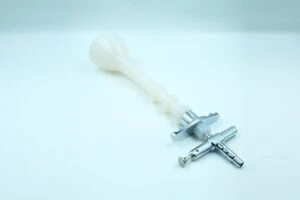
A vacuum delivery, also known as vacuum-assisted delivery, is a procedure in which a doctor uses a vacuum extractor to help guide a baby out of the birth canal during labor. This tool consists of a soft or rigid cup attached to the baby’s head and connected to a vacuum pump, creating suction to assist with the delivery.
While vacuum extraction can be an effective way to complete a difficult birth, improper use can lead to birth injuries for both the baby and the mother. Vacuum-assisted delivery is typically used when labor has stalled, the baby is showing signs of distress, or the mother is unable to push effectively due to exhaustion or medical conditions.
When performed correctly, it can prevent the need for a cesarean section (C-section), but improper use may result in complications. If a vacuum delivery leads to injury due to medical negligence, parents may have grounds for legal action and should contact an Arizona birth injury lawyer.
What Is a Vacuum Delivery and When Is It Necessary?
Doctors may recommend a vacuum-assisted delivery in specific situations where the baby needs assistance passing through the birth canal. Some of the most common reasons include:
- Prolonged second stage of labor: If pushing has continued for an extended period without progress, a vacuum can help safely complete the delivery.
- Fetal distress: If the baby is experiencing distress, such as an abnormal heart rate, the doctor may use a vacuum to speed up the delivery and reduce the risk of oxygen deprivation.
- Maternal exhaustion: Some mothers may not have the strength to continue pushing, especially after a long labor. The vacuum extractor can provide necessary assistance.
- Medical conditions affecting the mother: Women with heart disease, high blood pressure, or other conditions that limit their ability to push may benefit from vacuum assistance.
While vacuum delivery can be helpful in these situations, it is not suitable for all births. Doctors must carefully assess whether it is the safest option based on the mother’s and baby’s health.
"If your child was born with a birth injury, or cerebral palsy, we can help."
How Is a Vacuum Delivery Performed?
A vacuum-assisted delivery is performed during the second stage of labor, when the cervix is fully dilated, and the baby’s head is low in the birth canal. The procedure involves several steps:
- Positioning the vacuum cup: The doctor places a soft or rigid vacuum cup on the baby’s head, ensuring proper placement to avoid injury.
- Applying suction: Once the cup is positioned, suction is gradually increased to create a secure grip.
- Assisting the baby’s descent: As the mother pushes, the doctor gently pulls on the vacuum handle to help guide the baby through the birth canal.
- Releasing the vacuum: Once the baby’s head is delivered, the vacuum is removed, and the rest of the birth proceeds naturally.
The vacuum should only be applied for a short time, typically no more than three attempts, to reduce the risk of complications. If the vacuum delivery is unsuccessful, an emergency C-section may be necessary.
Potential Risks and Complications of Vacuum-Assisted Delivery
While vacuum delivery can be a useful tool, it also carries risks, particularly if not performed correctly. Some of the potential complications include:
Risks to the Baby
- Scalp injuries: The vacuum can cause swelling, bruising, or lacerations on the baby’s scalp.
- Cephalohematoma: A collection of blood between the skull and skin, which may take weeks to heal.
- Intracranial hemorrhage: In rare cases, excessive suction can cause bleeding in the baby’s brain, leading to long-term neurological issues.
- Brachial plexus injuries: If excessive force is used, the baby may suffer nerve damage affecting arm and shoulder movement.
- Skull fractures: Though uncommon, excessive pressure from the vacuum can cause fractures in the baby’s skull.
Risks to the Mother
- Vaginal or perineal tears: Vacuum delivery can increase the risk of severe tearing.
- Postpartum hemorrhage: The procedure may contribute to excessive bleeding after birth.
- Pelvic floor damage: Some women experience long-term pelvic pain or incontinence due to vacuum-assisted delivery.
Due to these risks, vacuum delivery should only be performed when medically necessary and by an experienced healthcare provider.
"We know first-hand what you are going through."
When Medical Negligence Leads to Birth Injuries
While many vacuum-assisted deliveries occur without issue, medical negligence can increase the risk of serious birth injuries. A doctor may be liable for malpractice if they:
- Used excessive force during the procedure
- Applied the vacuum incorrectly, causing avoidable injuries
- Failed to recognize when a vacuum delivery was inappropriate
- Delayed an emergency C-section when vacuum extraction was unsuccessful
If a vacuum delivery results in long-term injuries for the baby or mother due to improper medical care, legal action may be an option. A birth injury lawyer can review the case and determine whether medical malpractice occurred.
"Our Birth Injury Lawyers have recovered over $750+ Million on behalf of our clients."
Seeking Legal Help for Birth Injuries Related to Vacuum Delivery
Families facing birth injuries caused by vacuum-assisted delivery often experience emotional and financial hardship. Medical treatments, therapy, and long-term care may be necessary, leading to significant expenses.
In cases where negligence played a role, pursuing legal action can help families secure the compensation they need to cover these costs.
An experienced birth injury lawyer can investigate the circumstances of your child’s birth, consult medical experts, and build a case to hold responsible parties accountable.
If your baby suffered injuries due to improper vacuum delivery, you may be entitled to compensation for medical bills, lost wages, and pain and suffering.
Contact a Birth Injury Lawyer Today
If your child suffered injuries due to a vacuum-assisted delivery, you may have legal options. Medical negligence during birth can lead to serious, lifelong complications, and holding negligent providers accountable can provide the financial resources needed for your child’s care.
Birth Injury Lawyer Group can evaluate your case, explain your legal rights, and help you pursue compensation. Taking action now can help ensure your child receives the medical support they need. Contact our team today for a free consultation.
"We are committed to helping families who have suffered medical negligence."

